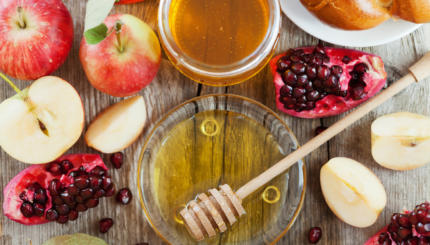The story of is recounted in the Book of Esther, whose eponymous heroine plays the leading role in saving her people from a massacre planned by the book’s villain, Haman. The word Purim means “lots” and refers to the mechanism by which Haman chose the date for the Jews’ destruction. The holiday is traditionally celebrated with wild abandon — costumes, drinking, feasting, revelry — and by reading the megillah and giving gifts to friends and the poor.
History of Purim
Did the events described in the Book of Esther actually happen? Historians have looked in vain for extra-biblical corroboration of the events of the story. However, the threat of antisemitism (and the awareness that sometimes it does result in bloody massacre) has remained with the Jewish community throughout countless centuries, so the story continues to resonate. What is certain is that Jews have celebrated the holiday of Purim for thousands of years.
Learn more about the history of Purim.
The Book of Esther
The Purim story purports to take place during a time when many Jews were living in Persia. A young Jewish woman, Esther, serendipitously rises to be queen of Persia, though she manages to keep her Jewish identity hidden from the king The reason for this soon becomes clear: The Jews have enemies, and in short order a man named Haman is appointed grand vizier and uses his newfound power to plot the Jews’ destruction. Even though Esther has hidden her Jewish identity from all, her guardian Mordecai prevails on her to risk her life by revealing her true identity to the king in the hopes of foiling Haman’s evil plan. When Esther reveals herself and denounces Haman, the king is unable to reverse the decree but the Jews are given license to defend themselves and end up killing the enemies who had risen up to slaughter them. For thousands of years, the story has offered hope to minority Jewish populations, often living in hostile majority cultures.

Help us keep Jewish knowledge accessible to millions of people around the world.
Your donation to My Jewish Learning fuels endless journeys of Jewish discovery. With your help, My Jewish Learning can continue to provide nonstop opportunities for learning, connection and growth.
Famously, God is never explicitly evoked in the Book of Esther. However, in Tractate Megillah, the talmudic tractate devoted to Purim observances, Rabbi Akiva declares the Book of Esther to be divinely inspired. Some commentators believe this eventually led to the inclusion of Esther in the Hebrew Bible, despite the omission of God from the book.
How to Celebrate Purim
The sages assigned four mitzvot, commandments, to Purim: (1) hearing the megillah, (2) giving gifts to the poor (matanot l’evyonim), (3) giving gifts to friends (mishloach manot) and (4) feasting.
The centerpiece of the communal celebration is the reading of the Scroll of Esther, the megillah, in the synagogue. This is a raucous affair, with participants dressing in costume and whoops, hollers and sundry noise being made every time that Haman’s name is mentioned. While clapping and stamping work to drown out the name of the genocidal villain, many people also use noise-makers called graggers. Another synagogue tradition is the Purim shpiel, or play, during which fun is poked at community leaders and members. Purim has often been called the Jewish carnival, and taking part in an actual carnival can heighten the levity of the day. In addition, this is the one holiday on which heavy drinking, usually discouraged by Jewish tradition, is recommended.
At home, Jews traditionally hold a feast on Purim called a seudah. This is an extra large and festive meal and upon reciting Birkat Hamazon, the Grace After Meals, it is traditional to add the prayer thanking God for miracles, Al HaNissim, which is also added on Hanukkah. Any delicious foods can be part of this meal, but many Jews eat traditional cookies called hamantaschen which are triangular in shape and hold a sweet filling. In addition, on Purim Jews send food gifts to one another, called mishloach manot, and give charitable donations.
How to Prepare for Purim
If Purim is approaching, here are a few things you might want to do to prepare:
- Figure out how you will hear the megillah. Synagogues everywhere host megillah readings, and you can also find them online.
- Plan your costume. You can dress up as a character from the Purim story or your favorite superhero. Or you can just grab a silly hat.
- Learn to bake hamantaschen. If you are culinarily-inclined, locate a great hamantaschen recipe. If that’s not your thing, many grocery stores in Jewish areas carry them this time of year.
- Shop for your mishloach manot and Purim seudah. Time to hit the grocery store or dive deep into your cupboards.
- Donate to your favorite charities. Purim is a time of celebrating Jewish good fortune and giving tzedakah to those less fortunate.
Learn more about Purim
You can learn more about Purim by exploring other articles on our website. For example:
- Find out why Jerusalem celebrates Purim a day later than other Jewish communities.
- Learn about the Jewish fast held on the day before Purim.
- Get pro-tips for folding hamantaschen.
- Learn to make your own gragger.
- Explore a Kurdish Jewish women’s holiday held right before Purim.
- Discover the secret connection between Purim and Yom Kippur.
- Check out the tomb where Esther and Mordechai are purported to be buried.
Happy Purim!



